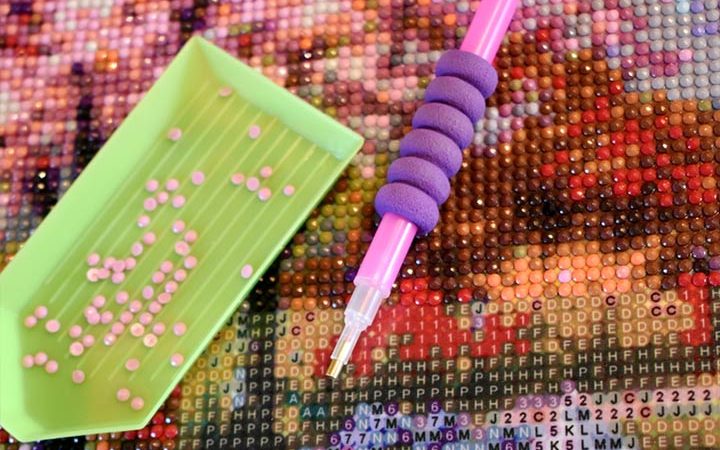Diamond painting is an art form in which images are broken down into small patterns. Similar to cross stitching and painting by numbers, the painting is believed to have originated from the mosaic art form.
You have to place tiny diamonds on a canvas surface to create a pattern. There are infinite patterns you can make. When you finish placing all the diamonds on the surface in the right place, you see the full image in its glorious form.
You can use these images as wall art or gift them to someone you love. These beautiful art forms become the focal point of any ordinary room. Whether you are four or forty, you are sure to enjoy this activity.
What Are The Benefits Of Diamond Painting For Kids?
Diamond painting for kids keeps them engaged for a long time and in a constructive way. They can express their ideas through this art.
1. Increases concentration
Diamond painting is the perfect activity to improve focus (1). While working on the canvas, kids’ attention is focused towards the end goal alone.
2. Aids relaxation
Acting as a meditative activity, diamond painting can calm down your child (2). They can perform this activity just before bedtime or in the afternoons after some energetic play sessions.
3. Teaches patience
Children, especially younger ones, may not be good at focus and patience. A diamond painting activity teaches them to patiently work on their art until the image is completed. It teaches them that hard work and perseverance can help them succeed.
4. Boosts confidence
When your child completes a diamond painting kit, they achieve a sense of satisfaction of having completed a project all by themselves. This, in turn, boosts their self-esteem and confidence. They start believing in their capabilities and are encouraged to try out other art forms too. Frame their first diamond painting and hang it in their bedroom to serve as a reminder of their dedication.
5. Allows exploring
Diamond painting is rarely taught in schools. While your child’s school might have other art forms, learning this art form will be a feather in your child’s cap. In fact, they might get curious and explore other techniques to create magical imagery.
6. Improves motor skills
Picking up a diamond and placing it in the correct spot helps in improving a child’s fine motor skills. You can give them different tools such as tweezers or pens to work with. This way, they learn to handle different objects and study how two different objects react with each other. This activity also increases their hand-eye coordination, color coordination and teaches them about cause and effect.
What Do Children Need For Diamond Painting?
To start learning diamond painting, beginners may need-
1. A diamond painting kit
They are available online, and you can get one according to your child’s interests. They are available in 3D and 5D versions.
2. Pen
Pens are tools that help you pick up the diamond and stick them to the surface. There are two types of pens – round and square-tipped – depending on the diamonds.
3. Canvas
This canvas or board is the place where everything will come together. They are color-coded to help your child paint on the surface.
4. Tweezers
In case your child is not comfortable with drills, tweezers can do the trick. They are useful to pick up the diamonds and place them in the right spot.
5. Wax
When you rub the tip of your pen with wax, it adheres to the diamond strongly. In fact, it acts like a magnet and allows your child to place the diamonds in an accurate fashion.
6. Tray
Use a tray or small cups to pour the diamonds. You can separate each color and place them on different trays or put them all together.
7. Work surface
The surface should be flat, fixed, and clean. Your dining table can double up as a work table for a diamond painting session.
8. Light
As the diamonds are tiny, your children need ample light to make sure they do not strain their eyes looking for them. Invest in a good quality table lamp.
What Does A Diamond Painting Kit Include?
When you purchase a high-quality diamond painting kit, it contains all the essentials you need for the painting.
- Canvas with color codes
- Diamond pens
- Resin diamonds
- Tweezers
- Wax
- Tray
What Are The Different Types Of Diamond Painting Kits?
According to your child’s age and experience, there are different types of diamond painting kits.
1. Round drills
Drills are another name for resin diamonds. Round drills are easier for beginners as you have to cover a lesser area. If your child is less than 10 years, choose this one.
2. Square drills
Square drills fit perfectly with each other and give a finished look on completion. If your child is over 10 or has a higher level of proficiency and patience, you can go for this kit.
3. Partial drills
Partial drills are a good choice for beginners and younger children. Partial drills basically mean that your canvas has to be only partially covered with diamonds.
4. Full drills
For older children or expert users, full drills are recommended. However, they take more time to finish as you have to completely cover the canvas with diamonds, thus creating a mosaic effect.
For younger children and beginners, choose round drills and partial drills. For older children and experts, choose square and full drills.
When Can Kids Start Using Diamond Painting Kits?
As younger children tend to put everything into their mouths, diamond painting kits are not recommended for children under the age of three. Usually, children start enjoying this activity around the age of six. You can gauge your child’s interest and see if they can manage the project. If your child is younger, you need to keep an eye to prevent them from swallowing the diamonds or any other potential harm.
What Is The Difference Between 5D And 3D Diamond Painting?
A 3D diamond has three sides, while a 5D diamond has five sides. Though both have similar features, 3D diamonds reflect lesser light, giving the image a dull appearance than the highly reflective 5D diamonds. When the image is completed, 5D diamonds look more realistic than 3D diamonds. Children prefer 5D diamonds because of their rich color range.
Tips For A Child’s First Diamond Painting Experience
These handy tips are sure to make your child’s first diamond painting experience memorable and fun.
1. Set the mood
Do not spring the activity as a surprise. Instead, talk to them about it and show some videos beforehand.
2. Pick a simple painting
There are a variety of designs available for diamond painting, and it is understandable if you want the image of the beautiful nighttime lake on your wall. But your child is just starting, and they can get overwhelmed if you present them with a complicated image when they are just starting out. Choose a simpler one in the beginning, and if they like it, you can gradually move to advanced paintings.
3. Timing matters
Your child cannot be expected to sit and start diamond painting when their mind is wandering. Hence, introduce this activity to your kids when they are in a calm state of mind or when they are relaxed. Maybe, try after dinner!
4. Participate with them
In the beginning, there will be a lot of mistakes. Your children are just learning the nuances of this new art form. Sit down and participate in the activity along with them.
5. Do not criticize
Criticism doesn’t help! So, bite your tongue and do not criticize them even if they do something wrong. Instead, you can praise and appreciate them for their efforts. Allow them to learn from their mistakes.
6. Place the canvas on a flat surface
Do not try this activity on your bed or couch. Use your dining or study table. The floor works too. Placing the canvas on a flat surface can give better results.
7. Sit comfortably
Remember that diamond painting is a relaxing activity. It means that you need to be seated comfortably without straining the neck or back.
8. Adequate lighting
Proper lighting is an extremely important aspect of diamond painting. Place the canvas near a steady and bright light source. You can also use a light pad for a magical experience.
9. Remove the sheet slowly
Many beginners make the mistake of removing the sheet completely when they start painting. Instead, peel off a small section, complete it, and then move on to the next section.
10. Take breaks
If your child is excited about the project, they may want to sit for long hours. It can cause neck pain and backaches. Set a timer and when it goes, ask your children to take a break, drink water, visit the washroom, or simply walk around.
11. Don’t force
If your child isn’t too excited about the project, don’t push them. Many times, children are put off by your insistence. Instead, give the activity a break. Introduce it to them again after a few days. They may want to give it another shot.
Regular painting is so passe! Let your child try something new. Diamond art kits can get your child hooked as they are equal amounts of challenge and fun. Who knows, when they complete a diamond painting, kids might ask for more.
References:
MomJunction’s articles are written after analyzing the research works of expert authors and institutions. Our references consist of resources established by authorities in their respective fields. You can learn more about the authenticity of the information we present in our editorial policy.
The following two tabs change content below.




































